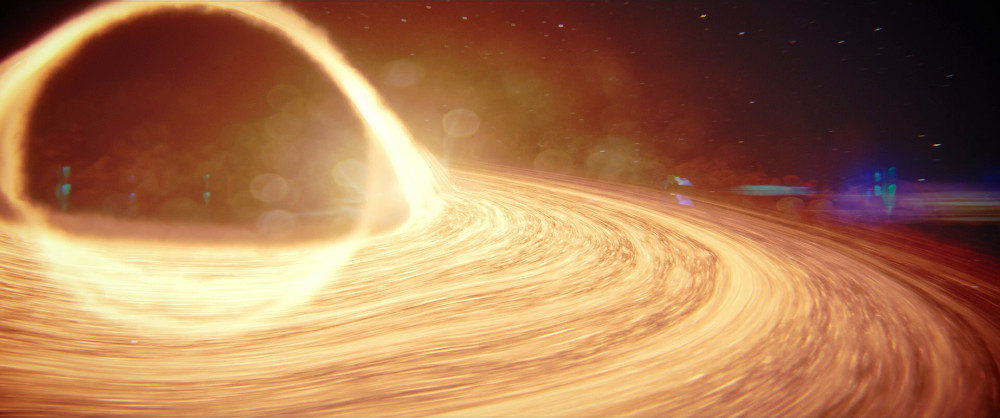Difference between revisions of "black hole"
m |
m |
||
| Line 2: | Line 2: | ||
{{TableRow|title=Advertising|data={{AmazonLinkSTSL}}}} | {{TableRow|title=Advertising|data={{AmazonLinkSTSL}}}} | ||
|}</div> | |}</div> | ||
| + | {{banner|Prime}} | ||
A black hole was a celestial object with a mass density so great that light could not escape it; the distance from the surface of the black hole at which its escape velocity is exactly equal to the [[speed of light]] was called the [[event horizon]]. Black holes could be formed when the core of a star collapsed in on itself after the outer layers exploded in a [[supernova]]: if the star's initial mass was greater than 8 [[stellar masses]], the resulting [[neutron star]]'s [[gravity]] would quickly cause it to collapse in upon itself until it became a black hole.<ref name="STSL"/> In [[2258]], the [[Talosians]] used their [[telepathy|powers of illusion]] to make [[Talos IV|their planet]] appear to be a black hole, hoping to deter an unwanted visit by [[Spock]] and [[Burnham, Michael|Michael Burnham]].<ref name="DSC23"/> Sometimes referred to as a black star, an encounter with a black hole on [[Stardate]] [[2267#SD3113|3113.2]] caused the [[U.S.S. Enterprise NCC-1701|U.S.S. ''Enterprise'' NCC-1701]] to [[time travel|travel back in time]] to [[1969]].<ref name="TOS21"/> | A black hole was a celestial object with a mass density so great that light could not escape it; the distance from the surface of the black hole at which its escape velocity is exactly equal to the [[speed of light]] was called the [[event horizon]]. Black holes could be formed when the core of a star collapsed in on itself after the outer layers exploded in a [[supernova]]: if the star's initial mass was greater than 8 [[stellar masses]], the resulting [[neutron star]]'s [[gravity]] would quickly cause it to collapse in upon itself until it became a black hole.<ref name="STSL"/> In [[2258]], the [[Talosians]] used their [[telepathy|powers of illusion]] to make [[Talos IV|their planet]] appear to be a black hole, hoping to deter an unwanted visit by [[Spock]] and [[Burnham, Michael|Michael Burnham]].<ref name="DSC23"/> Sometimes referred to as a black star, an encounter with a black hole on [[Stardate]] [[2267#SD3113|3113.2]] caused the [[U.S.S. Enterprise NCC-1701|U.S.S. ''Enterprise'' NCC-1701]] to [[time travel|travel back in time]] to [[1969]].<ref name="TOS21"/> | ||
| − | + | {{Wikipedia|Black_hole}} | |
{{References}} | {{References}} | ||
<references> | <references> | ||
Latest revision as of 08:40, 6 September 2023
A black hole was a celestial object with a mass density so great that light could not escape it; the distance from the surface of the black hole at which its escape velocity is exactly equal to the speed of light was called the event horizon. Black holes could be formed when the core of a star collapsed in on itself after the outer layers exploded in a supernova: if the star's initial mass was greater than 8 stellar masses, the resulting neutron star's gravity would quickly cause it to collapse in upon itself until it became a black hole.[1] In 2258, the Talosians used their powers of illusion to make their planet appear to be a black hole, hoping to deter an unwanted visit by Spock and Michael Burnham.[2] Sometimes referred to as a black star, an encounter with a black hole on Stardate 3113.2 caused the U.S.S. Enterprise NCC-1701 to travel back in time to 1969.[3]
Notes and References
- ↑ Bormanis, Andre. Star Trek: Science Logs. Pocket Books, March 1998.
- ↑ Fuller, Bryan et al (Executive Producers). "If Memory Serves". Star Trek: Discovery, season 2, episode 8 (Production number 23). Directed by T.J. Scott. Written by Dan Dworkin & Jay Beattie. CBS Entertainment. 7 March 2019.
- ↑ Roddenberry, Gene (Executive Producer). "Tomorrow is Yesterday." Star Trek, Season 1, Episode 19 (Production 21). Directed by Michael O'Herlihy. Written by D.C. Fontana. Desilu Productions, 26 January 1967.

